Stretch Basics for Patternmaking 3: Challenges for Non-Standard Figures
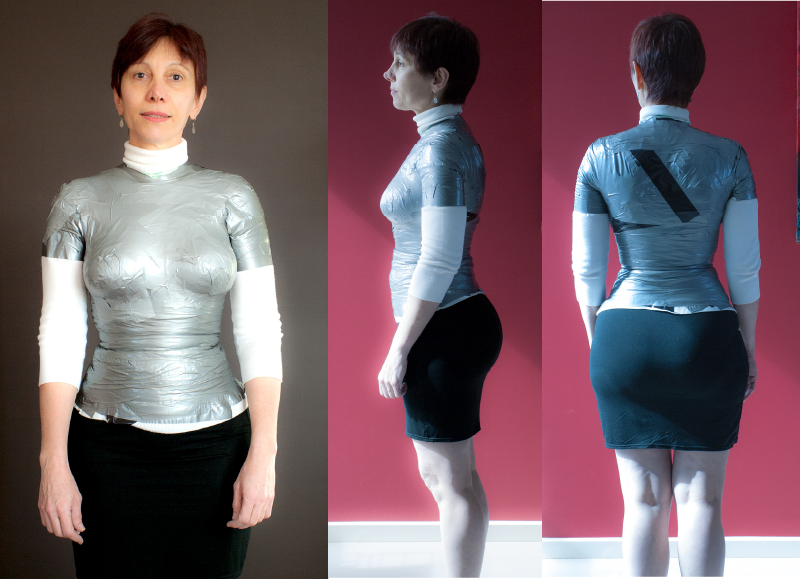
Woven vs Stretch
There is Part 3 of this article. Click here to go back to Part 2 Stretch Basics.
If you have a very curvy figure, darts and design lines are your friend. Darts and design lines help you to draft clothes that are close fitting and well-fitting. This is the conventional wisdom for clothing made from woven fabrics, but the conventional wisdom for knit fabrics is different. Most patternmaking references say that knits do not lend themselves to darts, and you should also keep design lines to a minimum.
Blocks for knits are drafted to be dartless, and most instructions for drafting knit blocks create the front and the back the same. The accepted wisdom is that given the stretch in knits it is possible for knit garments to fit a wide variety of figures without the use of design lines and darts. The miracle of knit means that it fits everyone well; i.e. it stretches where it needs to so conforms to the body, allowing the one garment to fit different body shapes. There also seems to be a perception that since knits are comfortable, they are also well fitting; however. when I actually observe people around me wearing knit garment, I note that many people’s clothes show the signs of bad fit; straining, pulling, drag lines, etc. Because the stretch in knits means clothing is more comfortable, the signs of a bad fit are overlooked. As usual, it is relatively easy to draft t-shirts and other other dartless garments for Standard Figures, but it's not always that simple for curvier figures.
I always keep in mind that the standard patternmaking theory that is taught to fashion designers in the fashion industry is all geared to a Standard Figure. Drafting simpler garments that (theoretically) fit a wider variety of figures improves their bottom line and sales. Cheaper to make, cheaper to sew. I think it's also in their interest to push the idea that stretch allows a garment to fit all types of figures, regardless of shape. BUT..... just because fabric can stretch to fit curvier figures, doesn't mean that it always flattering to the figure. Also, although knit fabrics stretches, you don't want to use the full value of the stretch. as the garment won't last very long. Stretching it to the maximum value in one place on the garment can also look unflattering.
If you have a figure with large differences in measurements between Upper Bust, Bust, Waist, and Hips, and you are relying purely on the stretch factor to get a close fit, then chances are that the fabric will be overstretching somewhere, unless you are using fabric with 100% stretch. The challenges for a good fit with knit garments affects mainly very curvy women; i.e. large differences between the key areas of your body. Particularly women with large bust cups (which means a significantly smaller upper bust), small waist and large hips.
Knit Blocks and the Curvy Figure
I want to look at the following issues in the rest of this article:
- Why the Knit Block with (almost) identical front and back armhole will not produce a good outcome for the curvy figure.
- Just because knits stretch, you shouldn't rely on stretch factor to shape your garments.
- If you don't rely on the stretch factor alone, and if you aren't supposed to use darts, how are you going to shape the garment?
- Why can't you use design lines?
Why the Knit Block with (almost) identical front and back armhole will not produce a good outcome for the curvy figure.
Some instructions for drafting a Knit Torso Block get you to draft the Back, then make the Front (almost) the same, except for the neckline curve. If you have a curvy figure and you have tried drafting a knit block with the back and the front the same, you would very likely have run into some problems. If you have any combination of: large bust, square shoulders, forward sloping shoulders, and especially all three, you will find having the back and front armhole shape the same an extremely bad fit. When you draft the front the same as the back, the end result is basically that you have transferred the side seam dart value into the armhole. While this can work for a standard figure, if you have a large bust you generally have a larger dart; if you transfer this dart into the armhole you will have an enormous front armhole.
In the image below you can see that if I transfer the value of my side seam dart into the armhole, my armhole would become proportionally so much bigger than would the Standard Block. The size of the my armhole would be ridiculously large in comparison to the original. Note that one of my other figure issues - my square shoulder, is exacerbating the problem. (Note that I am showing you the increase that would occur to the armhole rather than the final shapes of the blocks. If I showed you the final blocks they would look quite similar and therefore you might assume that my block is fine. Given that my armhole is significantly higher/smaller than the standard block, it is important to see the relative increase in the size of the armhole rather than the final shape of the block).
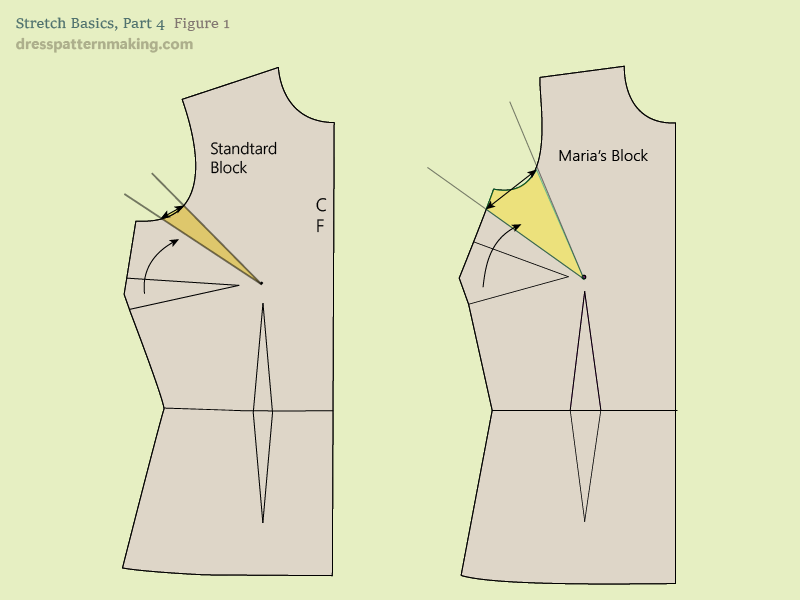
For the reasoning given above, if you have a large side seam bust dart, you are better off trying one of the other two methods I provide for drafting a Knit Block. Method B is moving the dart into the hem, which may work for you, depending on a number of factors including. This image shows have Method B works equally as badly for me as Method A.
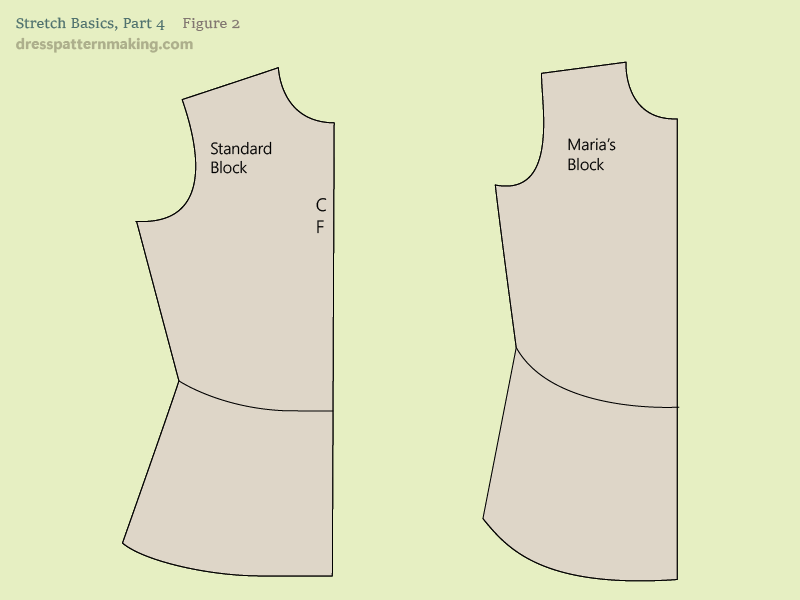
Here shows both Front and Back Torso Block using Method B for a Standard Block.
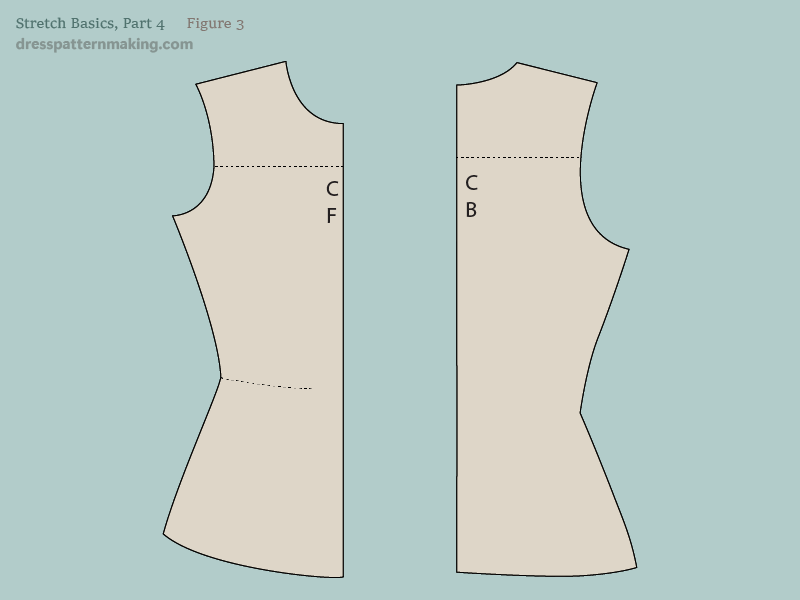
Method C is moving some of the dart into the armhole, and the rest into the hem.Shown here for my block only:
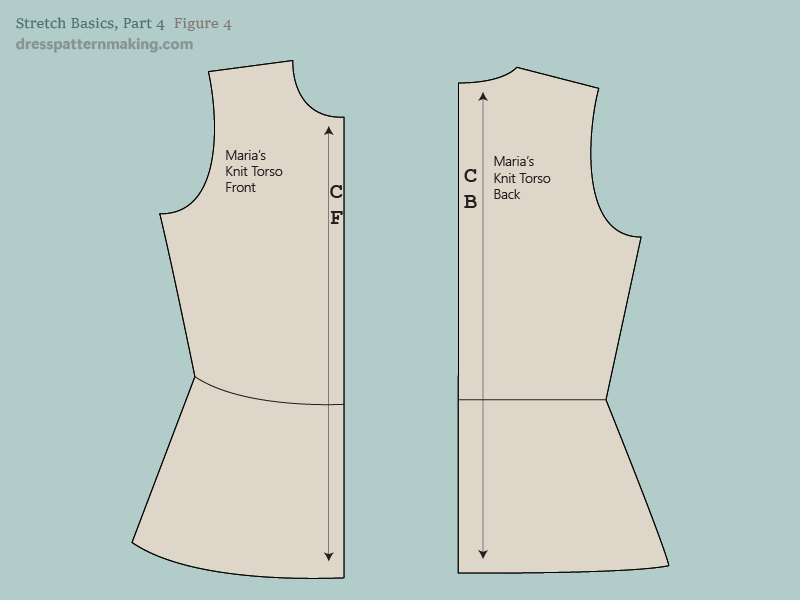
Just because Knits stretch, you shouldn't rely on stretch factor to shape your garments
If you have a very curvy figure and you try and draft a standard square T-shirt, you are unlikely to get a good fit. While this may seem obvious, this is the issue: sometimes when you purchase ready to wear garments and they don't fit, you don't know how much of the problem is that fact that it is drafted for a Standard Figure. You may think that if you drafting it and you get to choose whether to base it on the Upper Bust, the Bust or the hem, you might be able to get it to fit. Depending on your figure, you may well get a good fit or at least a better fit than in ready to wear clothes. But it is important to think it through and see whether or not you are on a fools' errand. Square shapes really don't suit a curvy figure, and it's not only a case of Upper Bust, Bust, Waist and Hips; how does the rest of your body affect the fit? I am going into this detail to show you it is important to realize that you can't rely on stretch to give you a well fitting garment. You have to understand your body and take the whole package into account. Here is just one example of the issues that I would face if trying to draft a t-shirt with a square silhouette. (Note that I am leaving out the waist shaping in this example; the waist shaping is just a distraction because the underlying problem of the basic foundation shape would still apply). At the top of this image shows a Standard Figure. There are two choices for drafting this top shown; basing the width of the t-shirt on the Bust measurement (left) or the hip measurement (right).
- In example A, the T-shirt width is based on the bust measurement. The width of the t-shirt is the same width of the bust all the way down; in this case it was a stable knit and the width of the garment is the exact bust measurement. The hips are a bit bigger than the bust, but the garment has about 18-25% stretch so given the small amount of difference between the bust and the hip, it will probably fit someone with a standard figure just fine. This will fit well across the bust with a little bit of extra ease in the armhole area. However, this person might prefer option 2, with the width based on the hip.
- in example B, the T-shirt width is based on the hip measurement. There is a little ease in the bust and a bit more ease in the underarm area.
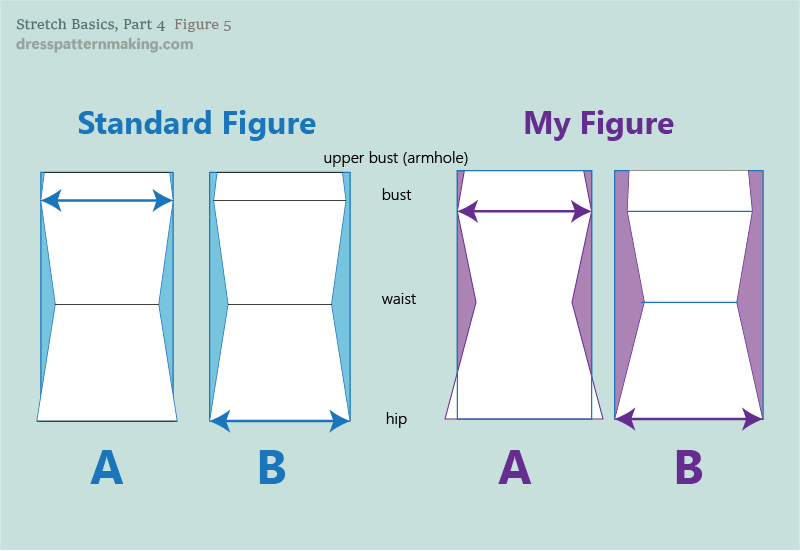
In this case the stretch of the fabric will probably mean that either option will work for someone with a standard figure. The two images to the right show my figure, with the same two choices:
- In example A, based on my bust, I actually have a little more ease in the armhole than the person with a standard figure - maybe a little loop of fabric. It is a bit tighter in the hip. If I want it fitting in the bust, it will be tight in the hip.
- In example B, based on my hip, it is going to be loose in the bust and very loose in the armhole. It will be fitting in the hip.
As I actually don't like anything, even stretch, really fitting in the hip (for reasons I will show in the next image), if I want a square T-shirt, I'm going to have to add ease in the hip and keep the square shape, then it will be enormous in the bust and the armhole. This photo shows why I don't like things fitting in the hip. Given my body shape and the fact that my stomach (though not large) protrudes past the line of my thighs. If the fabric is pulling across my hip then it accentuates my high round stomach and makes it look large.
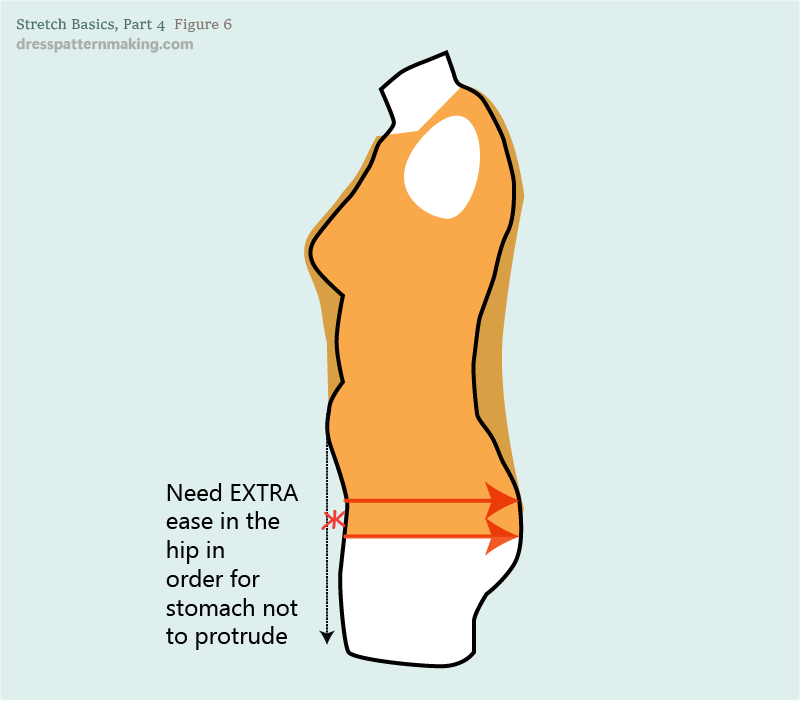
Now you might say the answer is simple - just add ease in the hip. Which is my whole point. If I start adding ease in the hip I am not relying in stretch do do the shaping. Not only am I adding some fullness in the hip, but what I end up with, since my Upper Bust is so small compared to my hip, is quite a wide A-shape. If I'm going to have an A-shape, I might as take that bit of extra ease out from my underarm and have it fitting in the bust. And do you know what? That is basically dart shaping. As you see here, the A-line from my Upper Bust to my (Hip + Ease) = bust shaping.
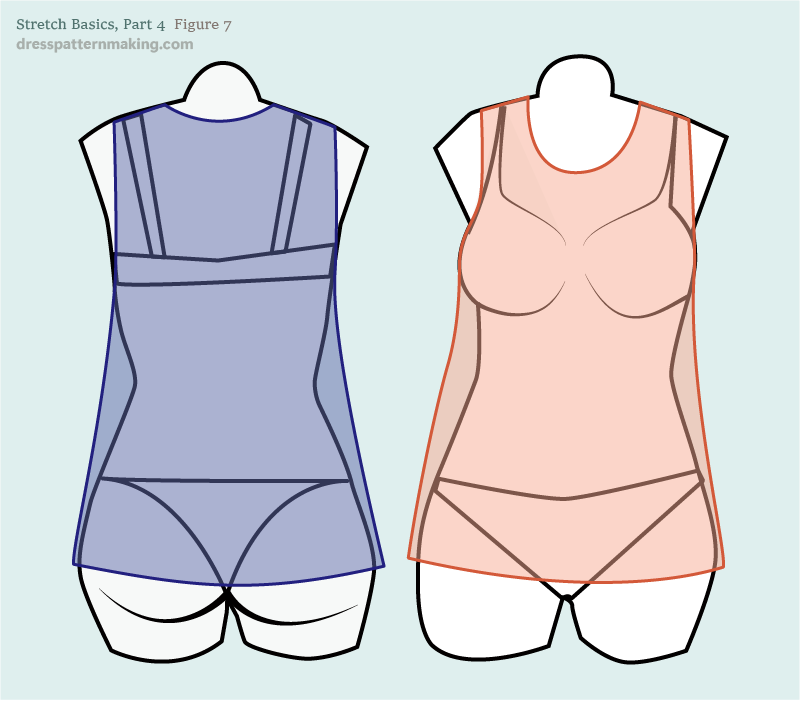
And my point is.... I am not relying on the stretch of the fabric to do all the styling to fit my figure. You need to use stretch where you can, but it isn't the be all and end all for styling. Which leads me to the next point.
If you don't rely on stretch factor alone, and if you are aren't supposed to use darts, how are you going to shape the garment?
When I first watched some tutorials on drafting patterns for knits, I watched the teacher take out all the darts in a (woven) Block to create a Knit Block. She then proceeded to draft a pattern with Added Fullness in the neckline, in the form of pleats. Let me say that again; she added fullness in the neckline to add pleats. Although this is part of the Style of the garment, it is in fact adding back in a dart value that is left as fullness.
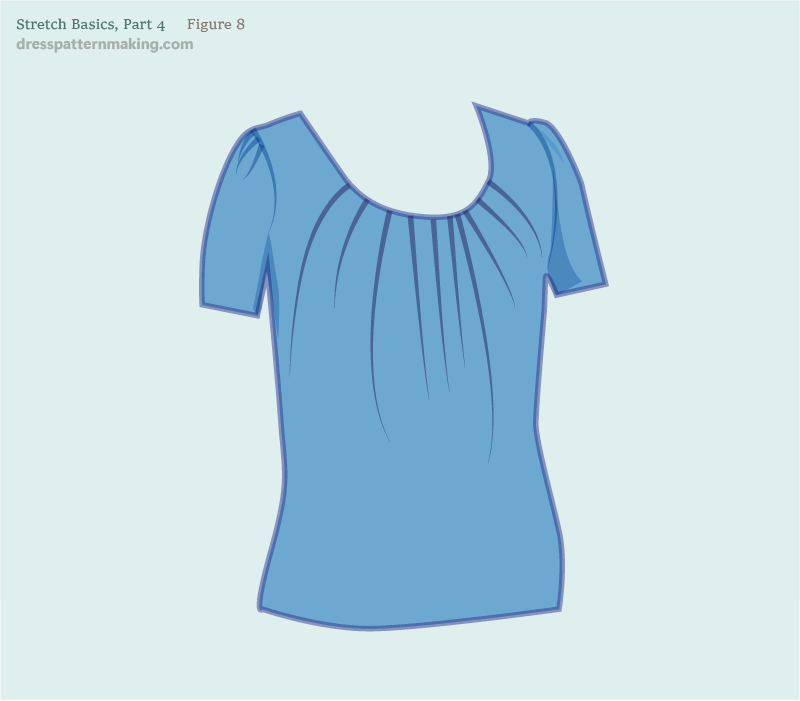
Even though the Knit Block is a dartless block, there is no reason you can't add dart values when drafting patterns. So don't misunderstand the conventional wisdom that you don't need darts; i.e. if you have a curvy figure you can add the dart equivalents back in as styling. Relying purely on the stretch factor of a fabric to shape the garment might get you an unflattering result. Chances are that if you have a full figure you will find that styles that have added fullness are much more comfortable, because this added fullness is acting as a dart would; creating more room for your breasts, or your hips, or wherever the curves are.
Why can't you use design lines?
The idea that you keep your design lines to a minimum with knit garments does not mean you can't use design lines. There is no reason that you cannot use princess lines if you want. This will get you a better fit. Even though the patternmaking textbooks suggest you keep the stylelines to a minimum, remember that those textbooks are generally talking to people in the industry; this is good practice for them. You can decide for yourself whether or not to add stylelines and how many to add. Look at commercial patterns for knit fabrics and you will see Princess Seams. Following are three photos: two of very unflattering and poor fitting ready-to-wear jersey dresses that have no dart shaping for the bust. Below that is a photo of a dress I made from jersey with princess stylelines. I could improve my dress (firstly by some better fabric! This was a toile out of cheap fabric) by taking out some of the ease. The fabric had 50% stretch and I used my Stretchwoven Block to draft the pattern. I could have taken out a significant amount of ease. Either way it is much more flattering and better fitting than the ready-to-wear ones. This ready-to-wear dress pulls too much in the bust and is funny around the armhole. It is generally unflattering.
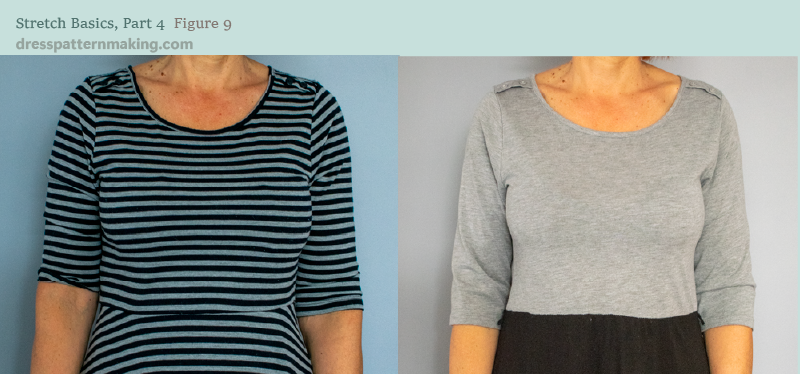
This one is tight in the upper bust and poorly fitting in the armhole. Here is my jersey dress - front and back - with princess stylelines.


